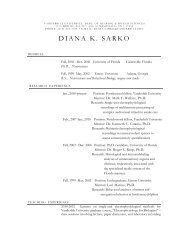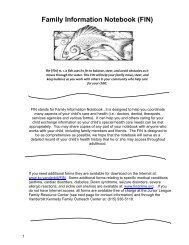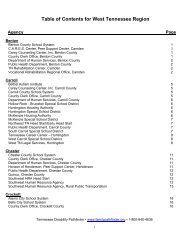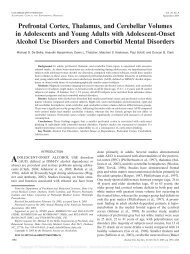ACTIVITY MONITOR - Vanderbilt Kennedy Center
ACTIVITY MONITOR - Vanderbilt Kennedy Center
ACTIVITY MONITOR - Vanderbilt Kennedy Center
Create successful ePaper yourself
Turn your PDF publications into a flip-book with our unique Google optimized e-Paper software.
MED ASSOCIATES INC. <strong>ACTIVITY</strong> <strong>MONITOR</strong><br />
Two Chamber Place Preference<br />
Two Chamber Place Preference is used for conditioned place preference paradigms. Like<br />
the Dark Box listed above, the Two Chamber Place Preference Insert is simply a box that<br />
slides into the chamber. After the box has been placed into the open-field environment<br />
the I/R array heights will need to be adjusted to ensure that the subjects are tracked<br />
properly (Chapter 1).<br />
The insert covers the entire area of the chamber. The outside of the box is constructed<br />
of clear polycarbonate. Stickers, paper, or any easily removable material may be applied<br />
to the outside of these clear walls to provide distinct visual stimuli to maximize<br />
contextual differences; however, do not cover the photo beams. Each side of the box<br />
has a different floor, grid rods and/or wire mesh. The lid is hinged to allow easy subject<br />
insertion and removal. A manual guillotine door is provided that allows the subject to<br />
pass freely, if so desired. As described above, the software can parse the session data<br />
into zones and determine the amount of time that a subject spends in either area.<br />
Applications for this insert include two chamber Conditioned Place Preference tests and<br />
other two chamber contextual protocols. Two Chamber Place Preference Inserts are<br />
available for the mouse and rat sized chambers.<br />
Hole Board Task Floor<br />
The Hole Board Task has been used for over ten years as a spatial orientation learning<br />
test, a short-term and long-term memory test, and an attention and curiosity monitoring<br />
protocol/device. The Hole Board Task Floor insert is placed into the open-field activity<br />
arena. The Hole Board Floor insert has 16 holes (four rows of four, equidistant holes)<br />
with an underlying food tray. The I/R Arrays must be attached using the lowest available<br />
screw holes. This places the photo-beams between the floor and the tray to detect<br />
entries into the holes. Food may be placed into the tray for learning and memory<br />
protocols using working and reference memory ratios. A second, non-reward application<br />
is to simply place the animal on to the Hole Board insert and monitor hole entries for<br />
novelty/curiosity assessment. Typical reward associated paradigms involve habituation,<br />
pre-testing protocols and non-habituation, no pre-testing protocols. See Chapter 7 and<br />
Appendix VII for more information on the running of this insert.<br />
- 40 -







